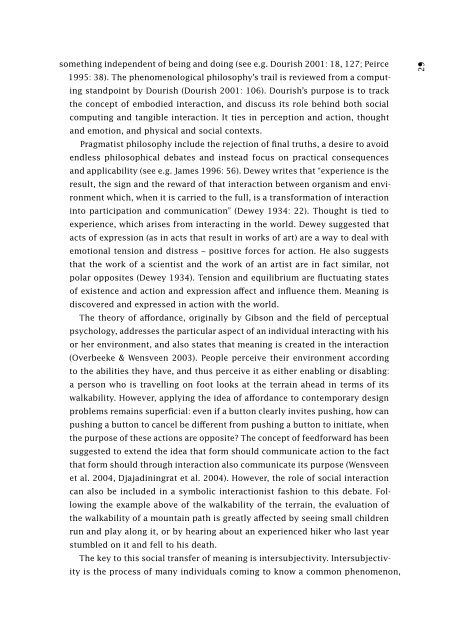Co-experience: Understanding user experiences in social interaction
Co-experience: Understanding user experiences in social interaction
Co-experience: Understanding user experiences in social interaction
Create successful ePaper yourself
Turn your PDF publications into a flip-book with our unique Google optimized e-Paper software.
someth<strong>in</strong>g <strong>in</strong>dependent of be<strong>in</strong>g and do<strong>in</strong>g (see e.g. Dourish 2001: 18, 127; Peirce<br />
1995: 38). The phenomenological philosophy’s trail is reviewed from a comput<strong>in</strong>g<br />
standpo<strong>in</strong>t by Dourish (Dourish 2001: 106). Dourish’s purpose is to track<br />
the concept of embodied <strong>in</strong>teraction, and discuss its role beh<strong>in</strong>d both <strong>social</strong><br />
comput<strong>in</strong>g and tangible <strong>in</strong>teraction. It ties <strong>in</strong> perception and action, thought<br />
and emotion, and physical and <strong>social</strong> contexts.<br />
Pragmatist philosophy <strong>in</strong>clude the rejection of f<strong>in</strong>al truths, a desire to avoid<br />
endless philosophical debates and <strong>in</strong>stead focus on practical consequences<br />
and applicability (see e.g. James 1996: 56). Dewey writes that “<strong>experience</strong> is the<br />
result, the sign and the reward of that <strong>in</strong>teraction between organism and environment<br />
which, when it is carried to the full, is a transformation of <strong>in</strong>teraction<br />
<strong>in</strong>to participation and communication” (Dewey 1934: 22). Thought is tied to<br />
<strong>experience</strong>, which arises from <strong>in</strong>teract<strong>in</strong>g <strong>in</strong> the world. Dewey suggested that<br />
acts of expression (as <strong>in</strong> acts that result <strong>in</strong> works of art) are a way to deal with<br />
emotional tension and distress – positive forces for action. He also suggests<br />
that the work of a scientist and the work of an artist are <strong>in</strong> fact similar, not<br />
polar opposites (Dewey 1934). Tension and equilibrium are fluctuat<strong>in</strong>g states<br />
of existence and action and expression affect and <strong>in</strong>fluence them. Mean<strong>in</strong>g is<br />
discovered and expressed <strong>in</strong> action with the world.<br />
The theory of affordance, orig<strong>in</strong>ally by Gibson and the field of perceptual<br />
psychology, addresses the particular aspect of an <strong>in</strong>dividual <strong>in</strong>teract<strong>in</strong>g with his<br />
or her environment, and also states that mean<strong>in</strong>g is created <strong>in</strong> the <strong>in</strong>teraction<br />
(Overbeeke & Wensveen 2003). People perceive their environment accord<strong>in</strong>g<br />
to the abilities they have, and thus perceive it as either enabl<strong>in</strong>g or disabl<strong>in</strong>g:<br />
a person who is travell<strong>in</strong>g on foot looks at the terra<strong>in</strong> ahead <strong>in</strong> terms of its<br />
walkability. However, apply<strong>in</strong>g the idea of affordance to contemporary design<br />
problems rema<strong>in</strong>s superficial: even if a button clearly <strong>in</strong>vites push<strong>in</strong>g, how can<br />
push<strong>in</strong>g a button to cancel be different from push<strong>in</strong>g a button to <strong>in</strong>itiate, when<br />
the purpose of these actions are opposite? The concept of feedforward has been<br />
suggested to extend the idea that form should communicate action to the fact<br />
that form should through <strong>in</strong>teraction also communicate its purpose (Wensveen<br />
et al. 2004, Djajad<strong>in</strong><strong>in</strong>grat et al. 2004). However, the role of <strong>social</strong> <strong>in</strong>teraction<br />
can also be <strong>in</strong>cluded <strong>in</strong> a symbolic <strong>in</strong>teractionist fashion to this debate. Follow<strong>in</strong>g<br />
the example above of the walkability of the terra<strong>in</strong>, the evaluation of<br />
the walkability of a mounta<strong>in</strong> path is greatly affected by see<strong>in</strong>g small children<br />
run and play along it, or by hear<strong>in</strong>g about an <strong>experience</strong>d hiker who last year<br />
stumbled on it and fell to his death.<br />
The key to this <strong>social</strong> transfer of mean<strong>in</strong>g is <strong>in</strong>tersubjectivity. Intersubjectivity<br />
is the process of many <strong>in</strong>dividuals com<strong>in</strong>g to know a common phenomenon,<br />
29

















